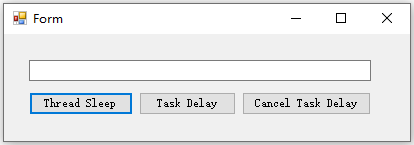C#: Thread.Sleep vs. Task.Delay (转载)

void PutThreadSleep() { Thread.Sleep(5000); } async Task PutTaskDelay() { await Task.Delay(5000); } private void btnThreadSleep_Click(object sender, EventArgs e) { PutThreadSleep(); MessageBox.Show("I am back"); } private async void btnTaskDelay_Click(object sender, EventArgs e) { await PutTaskDelay(); MessageBox.Show("I am back"); }
Basically there is nothing to describe about the code. (I am not going to explain the async and await keywords here; you can find many articles in MSDN and in my previous post explaining async/await). When I click both of these buttons, the message boxes will be displayed after 5 seconds. But there are significant differences between these two implementations. Let’s find out what's going on.
Thread.Sleep()
This is the classic way of suspending execution. This method will suspend the current thread until the given amount of time has elapsed. When you call Thread.Sleep in the above way, there is nothing you can do to abort this except waiting until the time elapses or by restarting the application. That’s because Thread.Sleep suspends the thread that's making the call. And because I'm calling Thread.Sleep in my button event handler (running in the UI thread), the UI is not responsive while it's sleeping.
Task.Delay()
Task.Delay acts in a very different way than Thread.Sleep. Basically, Task.Delay will create a task which will complete after a time delay. Task.Delay is not blocking the calling thread so the UI will remain responsive.
Behind the scenes there is a timer ticking until the specified time. Since the timer controls the delay, we can cancel the delay at any time simply by stopping the timer. To cancel, I am modifying the above PutTaskDelay method as follows:
CancellationTokenSource tokenSource = new CancellationTokenSource(); async Task PutTaskDelay() { try { await Task.Delay(5000, tokenSource.Token); } catch (TaskCanceledException ex) { } catch (Exception ex) { } }
In the call to Task.Delay I've added a cancellation token (more on that later). When the task gets cancelled, it will throw a TaskCanceledException. I am just catching the exception and suppressing it, because I don't want to show any message about that.
In my “Cancel Task Delay” button click event handler, I am using the cancellation token to signal the task to be cancelled:
private void btnCancelTaskDelay_Click(object sender, EventArgs e) { tokenSource.Cancel(); }
Once the task has been cancelled, the PutTaskDelay method returns immediately and the caller will show the message box.






【推荐】国内首个AI IDE,深度理解中文开发场景,立即下载体验Trae
【推荐】编程新体验,更懂你的AI,立即体验豆包MarsCode编程助手
【推荐】抖音旗下AI助手豆包,你的智能百科全书,全免费不限次数
【推荐】轻量又高性能的 SSH 工具 IShell:AI 加持,快人一步
· 10年+ .NET Coder 心语,封装的思维:从隐藏、稳定开始理解其本质意义
· .NET Core 中如何实现缓存的预热?
· 从 HTTP 原因短语缺失研究 HTTP/2 和 HTTP/3 的设计差异
· AI与.NET技术实操系列:向量存储与相似性搜索在 .NET 中的实现
· 基于Microsoft.Extensions.AI核心库实现RAG应用
· 10年+ .NET Coder 心语 ── 封装的思维:从隐藏、稳定开始理解其本质意义
· 地球OL攻略 —— 某应届生求职总结
· 提示词工程——AI应用必不可少的技术
· Open-Sora 2.0 重磅开源!
· 周边上新:园子的第一款马克杯温暖上架
2019-01-12 ASP.NET Core的Kestrel服务器(转载)